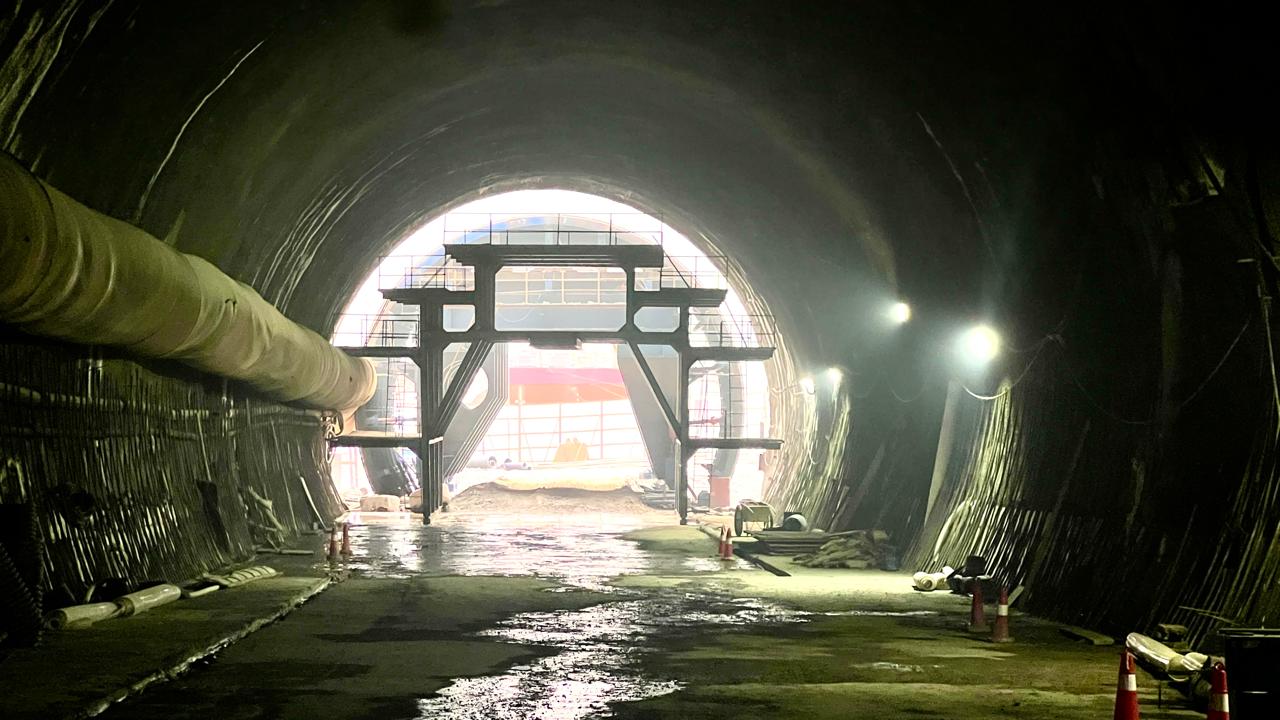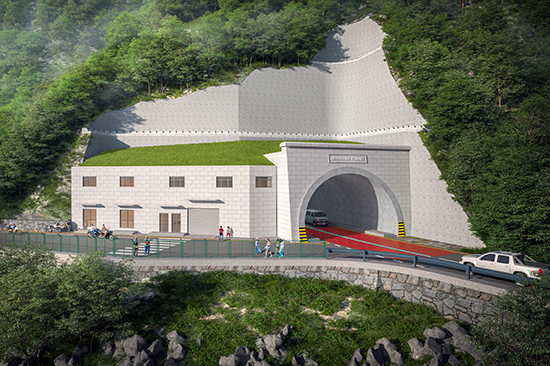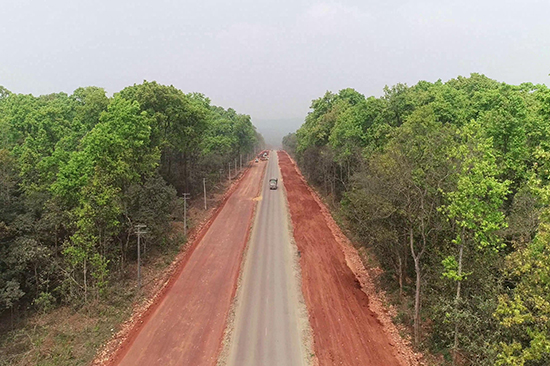Nagdhunga Tunnel | Balambu Flyover | Gwarko Flyover | Siddhababa Tunnel | Nepal infrastructure

the_farsight brings you progress updates on five undergoing infrastructure projects InCrisp. And they are —
Nagdhunga tunnel
The Nagdhunga Tunnel project has completed 82.7% of its physical work by November end, says its implementation division, while overall progress in financial implementation has reached 75.86% (as of October end).
The project has fully completed tunnel excavation and concrete lining works across the 5,499 metres length, including the main tunnel, evacuation tunnel, working audit, and cross passages.
Eleven out of 12 planned structures are finished. The 2.68 kilometres-long main tunnel connecting Satungal (Kathmandu) and Sisnekhola (Dhading) achieved the final breakthroughs earlier in April.
The project with an estimated cost of Rs 22.14 billion is funded by the Nepal government investing Rs 5.85 billion and the remaining amount is financed as loan by Japan under its Official Development Assistance.
Japanese company Hazama-Ando Corporation is constructing the project.
Originally planned for completion in three and a half years after its inception in 2019, the project faced delays due to the COVID-19 pandemic.
Balambu flyover
Meanwhile, work on a subsequent flyover in Balambu, a part of the Nagdhunga Tunnel Construction Project, is almost finished. The flyover will connect the Nagdhunga-Sisnekhola tunnel with the Tribhuvan Highway.
The 128 metres long and seven metres high flyover at Kisipidi, Balambu (Chandragiri Municipality) saw a final shape up in April and is expected to open to the public within a year. Upon completion, the flyover is expected to ease traffic flow on a busy intersection near Gurjudhara.
Gwarko flyover
Another flyover is under construction in Lalitpur to curb the traffic congestion at Gwarko Chowk along the Ring Road.
As of November, 80% of the work on the project has been completed.
Initiated in February 2022, the Rs 170.68 million four-lane flyover project was originally scheduled for completion in two years. However, a renewed deadline has been set adding an additional one year for mid-January 2025. The project cost overrun is estimated at Rs 440 million — an 158% more of the original cost.
A joint venture of Ashish-Samanantar-Religare — all Nepal-based construction companies — is building the flyover under the Engineering, Procurement, and Construction (EPC) model. The project encountered multiple delays, citing technical issues, monsoon rains and design modifications.
The flyover features a 320 metres ramp on the Balkumari side and 185 metres on the Satdobato side, with the bridge itself spanning 35 metres and a vertical clearance of 6 metres at the crossroad.
Siddhababa tunnel
The Siddhababa Tunnel Project, under the EPC model, was signed in March 2022 to be completed within five years (by March 2027). However, the work began in January 2024 only.
The 1.126 kilometres long tunnel project has a north portal at Ramapithecus Park and south portal near Siddha Baba Temple at Siddhababa-Dobhan road section in Palpa district. It features a double-lane main tunnel with sidewalks and three bypasses for emergency exits.
As of September 2024, the main tunnel, stretching 1,126 metres, has seen 587.22 metres progress and is expected to finish by December. Meanwhile, two bypasses spanning 151 metres and 130 metres have been completed while the third bypass (161 metres) is nearing completion with 117 metres excavated so far.
Overall, the project has achieved 24.17% physical and 26.4% financial progress, with a 10% advancement in the past month thanks to night drilling and day blasting operations. The project also includes road upgrades near the tunnel, and a 500 metres rock shed and barrier to divert rockslides.
The China State Construction Engineering Corporation (CSCEC) is building the tunnel for Rs 7.34 billion funded solely by the Nepal government.

Upon completion, it will be the first fast route linking the emerging southern cities (Bhairahawa through Butwal) to Pokhara, one of Nepal’s largest cities. Another key objective of the project is to address the frequent landslides and rockslides along the hazardous section on the Siddhartha Highway.
Narayanghat-Butwal road expansion
The 113 km long Narayanghat-Butwal road expansion classified as a ‘strategic high-priority road’ is one of the most anticipated projects signed in 2019. But only 52% physical progress has been achieved while 44% of the payment is released to the contractor.
The Asian Development Bank (ADB) is financing the project on loan amounting to Rs 16.99 billion under its South Asia Subregional Economic Cooperation (SASEC) Roads Improvement Project (SRIP) undertaking.
The CSCEC is building the road at a cost of NRs 9.13 billion for the eastern section (48 km Gaindakot-Daunne) and NRs 7.86 billion for the western section (65 km Daunne-Butwal).

The project includes six lane roads in marketplaces, four lanes in forest cover, and three lanes in Daunne and will be built to an all-weather asphalt concrete Asian Highway Standard.
The project had missed its original deadline for July 2022 due to COVID-19 and shortening of construction resources. The deadline was extended to August 28, 2023 for the eastern section and July 27, 2023 for the western section.
After failing to meet these deadlines citing delay of permission for site clearance like cutting down of trees, it was extended for the second time to July 2024.
Yet again, it was extended for the third time in July 2024, with the renewed deadline set for July 23, 2025.
Upon completion, the Narayanghat-Butwal road will improve passenger as well as cargo mobility joining significant urban markets and intersections on national highways such as Rupandehi’s Butwal and Chitwan’s Bharatpur. The road will also provide better connectivity to the Gautam Buddha International Airport for the eastern districts, additionally reducing travel time between major tourism spots like Chitwan National Park and Lumbini.
More importantly, once completed, it will relieve passengers, residents and marketplaces’ settlers from the ongoing construction pollution.
Read More Stories
Kathmandu’s decay: From glorious past to ominous future
Kathmandu: The legend and the legacy Legend about Kathmandus evolution holds that the...
Kathmandu - A crumbling valley!
Valleys and cities should be young, vibrant, inspiring and full of hopes with...
Nepal’s high-altitude farms are thirsty. Could ice stupas help?
As snowlines rise and mountain springs run dry, Nepals high-altitude communities are facing...